Health Care > NCLEX-PN > NCLEX PN TEST BANK: NCLEX PN Exam Test Bank; Latest Updated:Actual Test Questions & Answers: Guarant (All)
NCLEX PN TEST BANK: NCLEX PN Exam Test Bank; Latest Updated:Actual Test Questions & Answers: Guaranteed A+ Score
Document Content and Description Below
Teaching the client with gonorrhea how to prevent reinfection and further spread is an example of: A. primary prevention. B. secondary prevention. C. tertiary prevention. D. primary healt... h care prevention. Answer: B Explanation: Secondary prevention targets the reduction of disease prevalence and disease morbidity through early diagnosis and treatment.Physiological Adaptation Question No : 2 - (Topic 1) Which of the following foods is a complete protein? A. corn B. eggs C. peanutsDsunflower seeds Answer: B Explanation: Eggs are a complete protein. The remaining options are incomplete proteins.Health Promotion and Maintenance Question No : 3 - (Topic 1) Broccoli, oranges, dark greens, and dark yellow vegetables can be eaten to: A. supplement vitamin pills. B. balance body molecules. C. cure many diseases. D. help improve body defenses. Answer: D Explanation: Controversy over what types of food to eat and not eat is still under investigation. Certain foods can help improve body defenses to possibly prevent certain diseases.Nonpharmacological Therapies Question No : 4 - (Topic 1) The major electrolytes in the extracellular fluid are: A. potassium and chloride. B. potassium and phosphate. C. sodium and chloride. D. sodium and phosphate. Answer: C Explanation: Sodium and chloride are the major electrolytes in the extracellular fluid.Physiological Adaptation Question No : 5 - (Topic 1) Which of the following nursing diagnoses might be appropriate as Parkinson’s disease progresses and complications develop? A. Impaired Physical Mobility B. Dysreflexia C. Hypothermia D. Impaired Dentition Answer: A Explanation: The client with Parkinson’s disease can develop a shuffling gait and rigidity, causing impaired physical mobility. The other diagnoses do not necessarily relate to a client with Parkinson’s disease.Reduction of Risk Potential Question No : 6 - (Topic 1) Which of the following is an inappropriate item to include in planning care for a severely neutropenic client? A. Transfuse netrophils (granulocytes) to prevent infection. B. Exclude raw vegetables from the diet. C. Avoid administering rectal suppositories. D. Prohibit vases of fresh flowers and plants in the client’s room. Answer: A Explanation: Granulocyte transfusion is not indicated to prevent infection. Produced in the bone marrow, granulocytes normally comprise 70% of all WBCs. They are subdivided into three types based on staining properties: neutrophils, eosinophils, and basophils. They can be beneficial in a selected population of infected, severely granulocytopenic clients (less than 500/mm3) who do not respond to antibiotic therapy and who are expected to experience prolonged suppression of granulocyte production.Physiological Adaptation Question No : 7 - (Topic 1) A primary belief of psychiatric mental health nursing is: A. most people have the potential to change and grow. B. every person is worthy of dignity and respect. C. human needs are individual to each person. D. some behaviors have no meaning and cannot be understood. Answer: B Explanation: Every person is worthy of dignity and respect. Every person has the potential to change and grow. All people have basic human needs in common with others. All behavior has meaning and can be understood from the client’s perspective.Psychosocial Integrity Question No : 8 - (Topic 1) A teenage client is admitted to the hospital because of acetaminophen (Tylenol) overdose. Overdoses of acetaminophen can precipitate life-threatening abnormalities in which of the following organs? A. lungs B. liver C. kidneys D. adrenal glands Answer: B Explanation: Acetaminophen is extensively metabolized in the liver. Choices 1, 3, and 4 are incorrect because prolonged use of acetaminophen might result in an increased risk of renal dysfunction, but a single overdose does not precipitate life-threatening problems in the respiratory system, renal system, or adrenal glands.Pharmacological Therapies Question No : 9 - (Topic 1) All of the following factors, when identified in the history of a family, are correlated with poverty except: A. high infant mortality rate. B. frequent use of Emergency Departments. C. consultation with folk healers. D. low incidence of dental problems. Answer: D Explanation: Dental problems are prevalent because of the lack of preventive care and access to care. High infant mortality is one of the most significant problems correlated with poverty. Pregnant women who do not have access to care might come to the Emergency Department when in labor. Those in poverty are likely to use Emergency Departments because they may not be turned away. Those in poverty might also turn to folk healers or other persons in their community for care who might be easier to access and might not demand payment.Health Promotion and Maintenance Question No : 10 - (Topic 1) Acyclovir is the drug of choice for: A. HIV. B. HSV 1 and 2 and VZV. C. CMV. D. influenza A viruses. Answer: B Explanation: Acyclovir (Zovirax) is specific for treatment of herpes virus infections. There is no cure for herpes. Acyclovir is excreted unchanged in the urine and therefore must be used cautiously in the presence of renal impairment. Drugs that treat herpes inhibit viral DNA replication by competing with viral substrates to form shorter, ineffective DNA chains.Physiological Adaptation Question No : 11 - (Topic 1) Ashley and her boyfriend Chris, both 19 years old, are transported to the Emergency Department after being involved in a motorcycle accident. Chris is badly hurt, but Ashley has no apparent injuries, though she appears confused and has trouble focusing on what is going on around her. She complains of dizziness and nausea. Her pulse is rapid, and she is hyperventilating. The nurse should assess Ashley’s level of anxiety as: A. mild. B. moderate. C. severe. D. panic. Answer: C Explanation: The person whose anxiety is assessed as severe is unable to solve problems and has a poor grasp of what’s happening in his or her environment. Somatic symptoms such as those described by Ashley are usually present. Vital sign changes are observed. The individual with mild anxiety might report being mildly uncomfortable and might even find performance enhanced. The individual with moderate anxiety grasps less information about the situation, has some difficulty problem-solving, and might have mild changes in vital signs. The individual in panic demonstrates markedly disturbed behavior and might lose touch with reality.Psychosocial Integrity Question No : 12 - (Topic 1) Which of the following methods of contraception is able to reduce the transmission of HIV and other STDs? A. intrauterine device (IUD) B. Norplant C. oral contraceptives D. vaginal sponge Answer: D Explanation: The vaginal sponge is a barrier method of contraception that, when used with foam or jelly contraception, reduces the transmission of HIV and other STDs as well as reducing the risk of pregnancy. IUDs, Norplant, and oral contraceptives can prevent pregnancy but not the transmission HIV and STDs. Clients using the contraceptive methods in Choices 1, 2, and 3 should be counseled to use a chemical or barrier contraceptive to decrease transmission of HIV or STDs.Health Promotion and Maintenance Question No : 13 - (Topic 1) Which fetal heart monitor pattern can indicate cord compression? A. variable decelerations B. early decelerations C. bradycardia D. tachycardia Answer: A Explanation: Variable decelerations can be related to cord compression. The other patterns are not.Reduction of Risk Potential Question No : 14 - (Topic 1) The nurse teaching about preventable diseases should emphasize the importance of getting the following vaccines: A. human papilloma virus, genital herpes, measles. B. pneumonia, HIV, mumps. C. syphilis, gonorrhea, pneumonia. D. polio, pertussis, measles. Answer: D Explanation: Vaccines are one of the most effective methods of preventing and controlling certain communicable diseases. The smallpox vaccine is not currently in use because the smallpox virus has been declared eradicated from the world’s population. Diseases such as polio, diphtheria, pertussis, and measles are mostly controlled by routine childhood immunization. They have not, however, been eradicated, so children need to be immunized against these diseases.Physiological Adaptation Question No : 15 - (Topic 1) Which of the following conditions is mammography used to detect? A. pain B. tumor C. edema D. epilepsy Answer: B Explanation: Mammography is used to detect tumors or cysts in the breasts, not the other conditions.Reduction of Risk Potential Question No : 16 - (Topic 1) When the nurse is determining the appropriate size of an oropharyngeal airway to insert, what part of a client’s body should she measure? A. corner of the mouth to the tragus of the ear B. corner of the eye to the top of the ear C. tip of the chin to the sternum D. tip of the nose to the earlobe Answer: A Explanation: An oropharyngeal airway is measured from the corner of the client’s mouth, to the tragus of the ear. Reduction of Risk Potential Question No : 17 - (Topic 1) Which sign might the nurse see in a client with a high ammonia level? A. coma B. edema C. hypoxia D. polyuria Answer: A Explanation: Coma might be seen in a client with a high ammonia level.Reduction of Risk Potential Question No : 18 - (Topic 1) What do the following ABG values indicate: pH 7.38, PO2 78 mmHg, PCO2 36mmHg, and HCO3 24 mEq/L? A. metabolic alkalosis B. homeostasis C. respiratory acidosis D. respiratory alkalosis Answer: B Explanation: These ABG values are within normal limits. Choices 1, 3, and 4 are incorrect because the ABG values indicate none of these acid-base disturbances.Physiological Adaptation Question No : 19 - (Topic 1) Which of the following is the primary force in sex education in a child’s life? A. school nurse B. peers C. parents D. media Answer: C Explanation: Parents are the primary force in sex education in a child’s life. The school nurse is involved with formal sex education and counseling. Peers become more important in sex education during adolescence but might lack correct information. The media play a powerful role in what children learn about sex through movies, TV, and video games.Health Promotion and Maintenance Question No : 20 - (Topic 1) The nurse is assessing the dental status of an 18-month-old child. How many teeth should the nurse expect to examine? A. 6 B. 8 C. 12 D. 16 Answer: C Explanation: In general, children begin dentition around 6 months of age. During the first 2 years of life, a quick guide to the number of teeth a child should have is as follows: Subtract the number 6 from the number of months in the age of the child. In this example, the child is 18 months old, so the formula is 18 – 6 = 12. An 18-month-old child should have approximately 12 teeth.Health Promotion and Maintenance Question No : 21 - (Topic 1) Which of the following medications is a serotonin antagonist that might be used to relieve nausea and vomiting? A. metoclopramide (Reglan) B. onedansetron (Zofran) C. hydroxyzine (Vistaril) D. prochlorperazine (Compazine) Answer: B Explanation: Zofran is a serotonin antagonist that can be used to relieve nausea and vomiting. The other medications can be used for nausea and vomiting, but they have different mechanisms of action.Physiological Adaptation Question No : 22 - (Topic 1) A client is complaining of difficulty walking secondary to a mass in the foot. The nurse should document this finding as: A. plantar fasciitis. B. hallux valgus. C. hammertoe. D. Morton’s neuroma. Answer: D Explanation: Morton’s neuroma is a small mass or tumor in a digital nerve of the foot. Hallux valgus is referred to in lay terms as abunion.Hammertoe is where one toe is cocked up over another toe. Plantar fasciitis is an inflammation of, or pain in, the arch of the foot.Basic Care and Comfort [Show More]
Last updated: 1 year ago
Preview 1 out of 415 pages
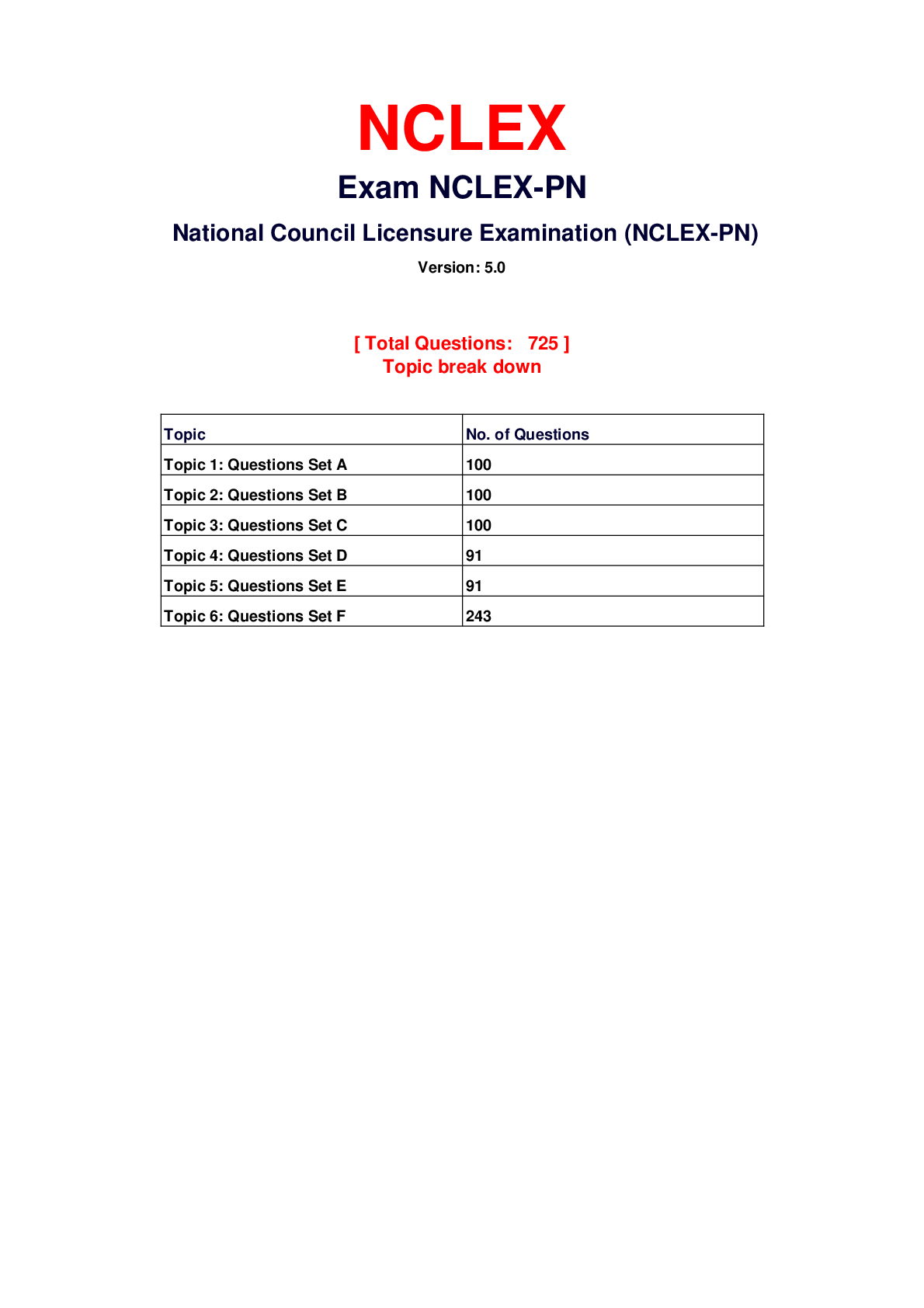
Reviews( 0 )
Document information
Connected school, study & course
About the document
Uploaded On
Nov 03, 2022
Number of pages
415
Written in
Additional information
This document has been written for:
Uploaded
Nov 03, 2022
Downloads
0
Views
82

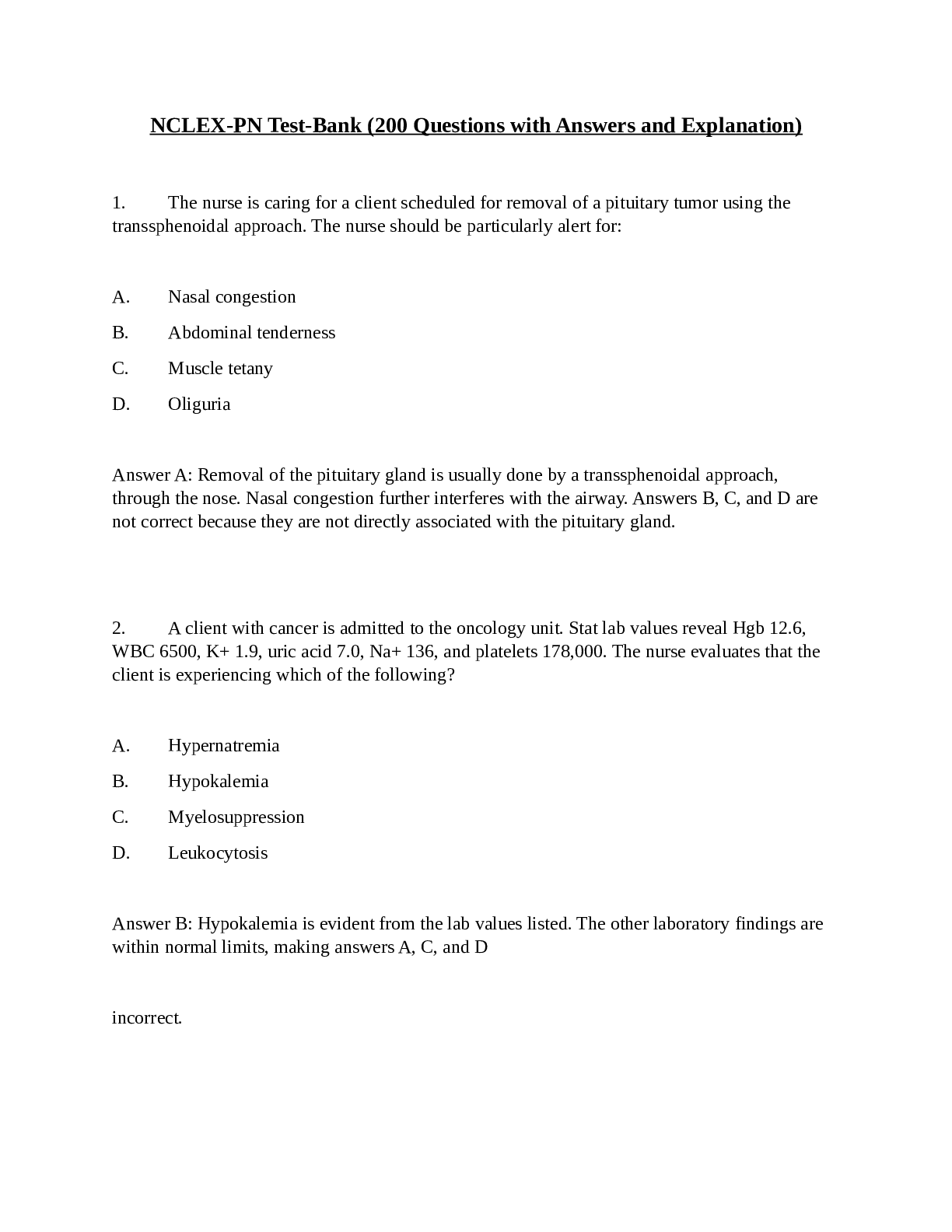


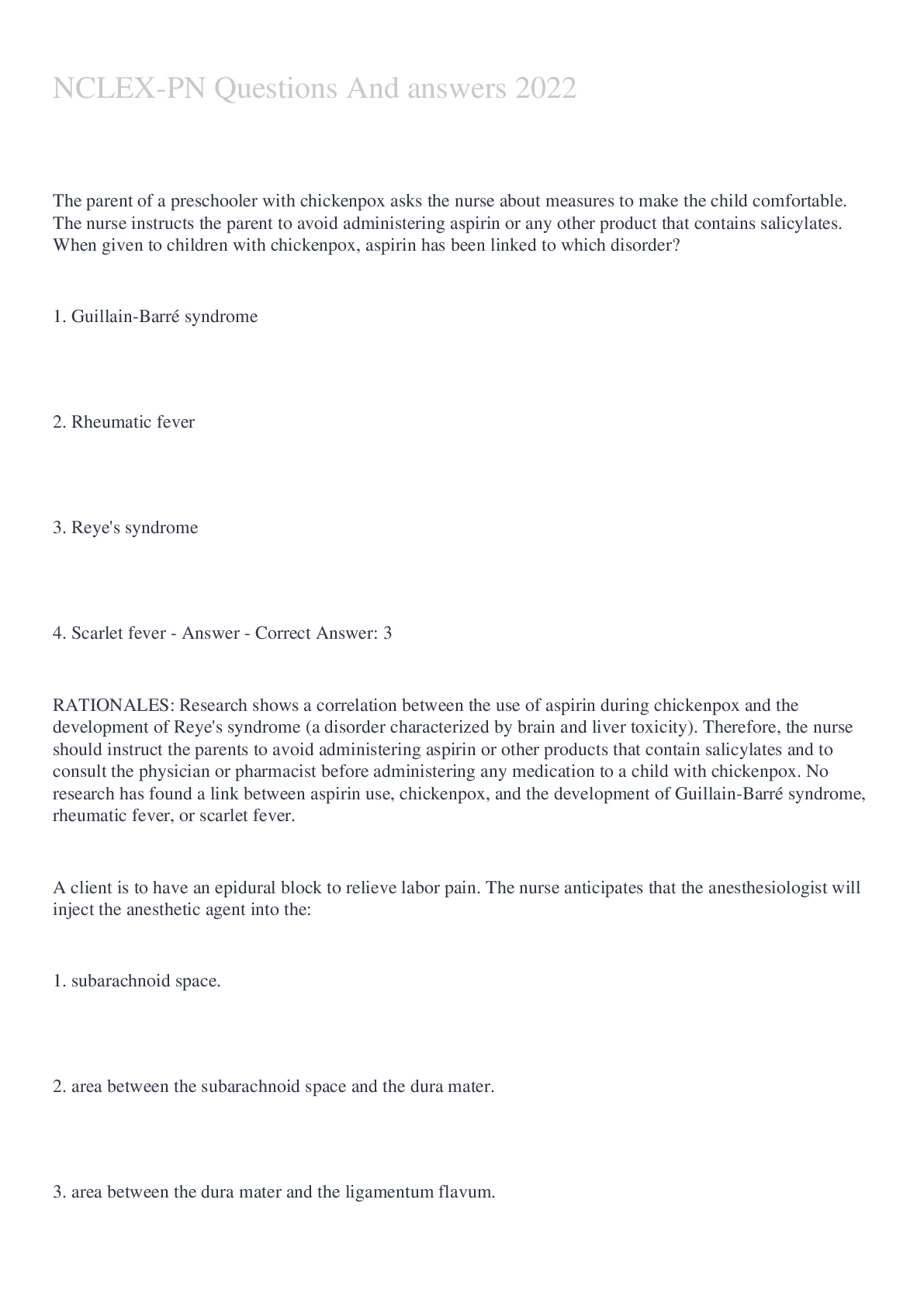

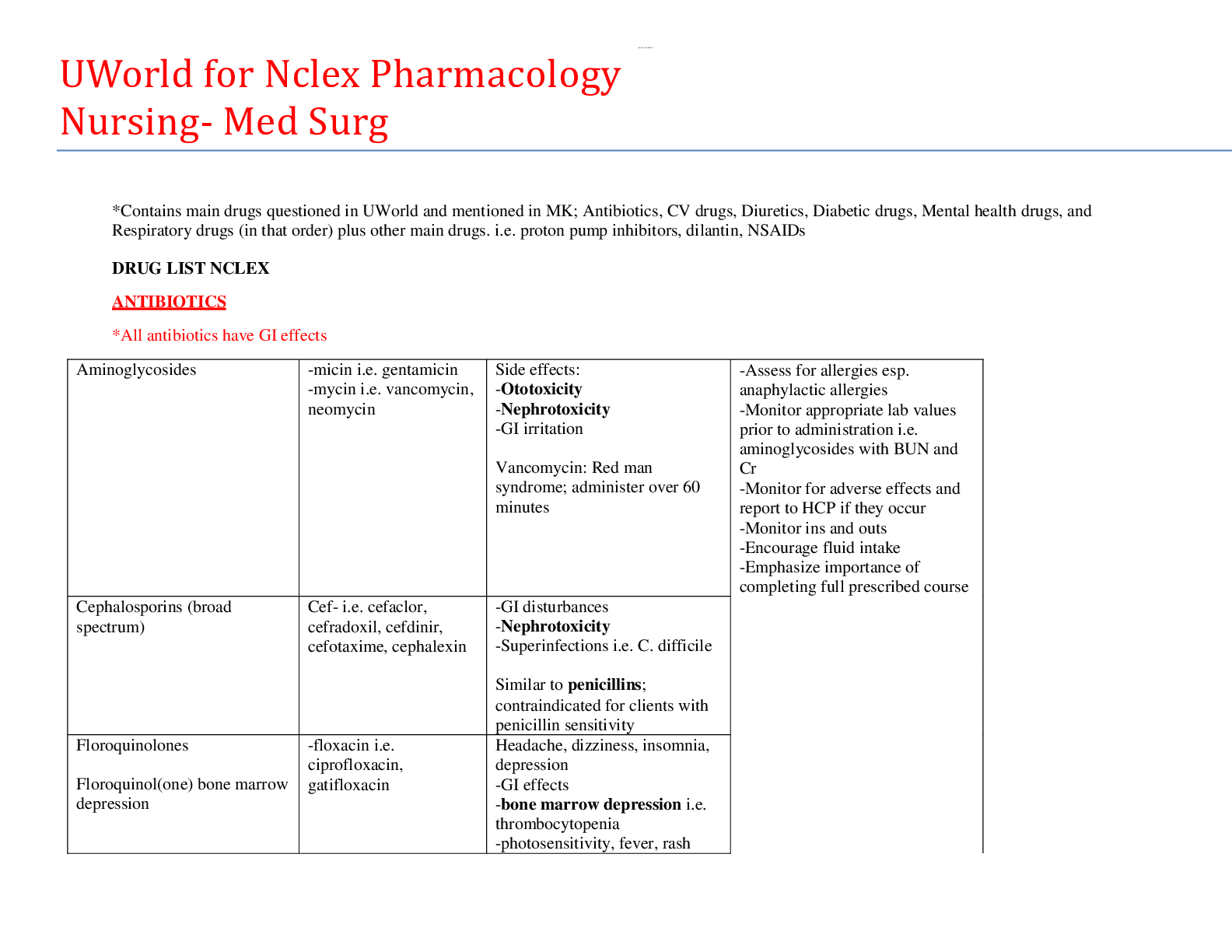

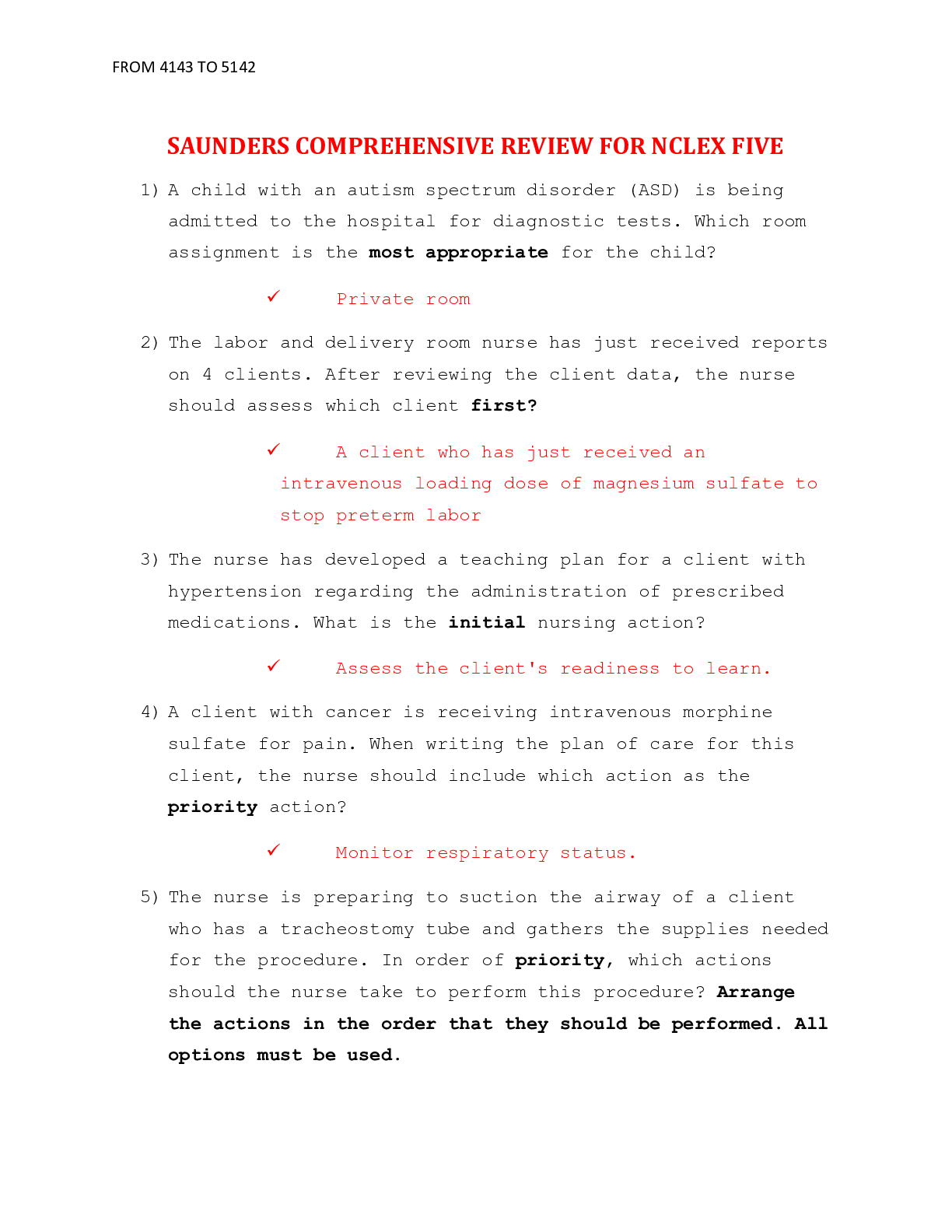
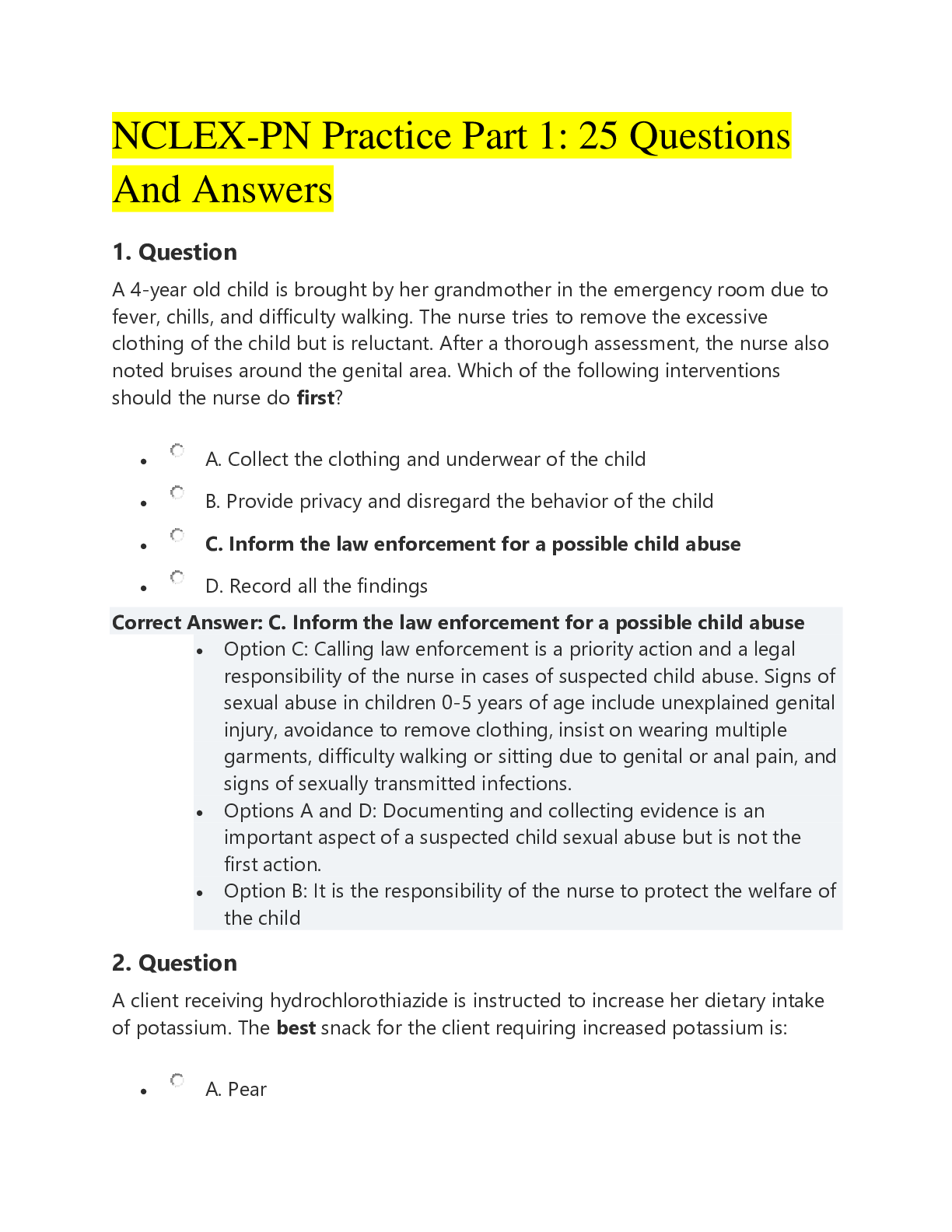
.png)
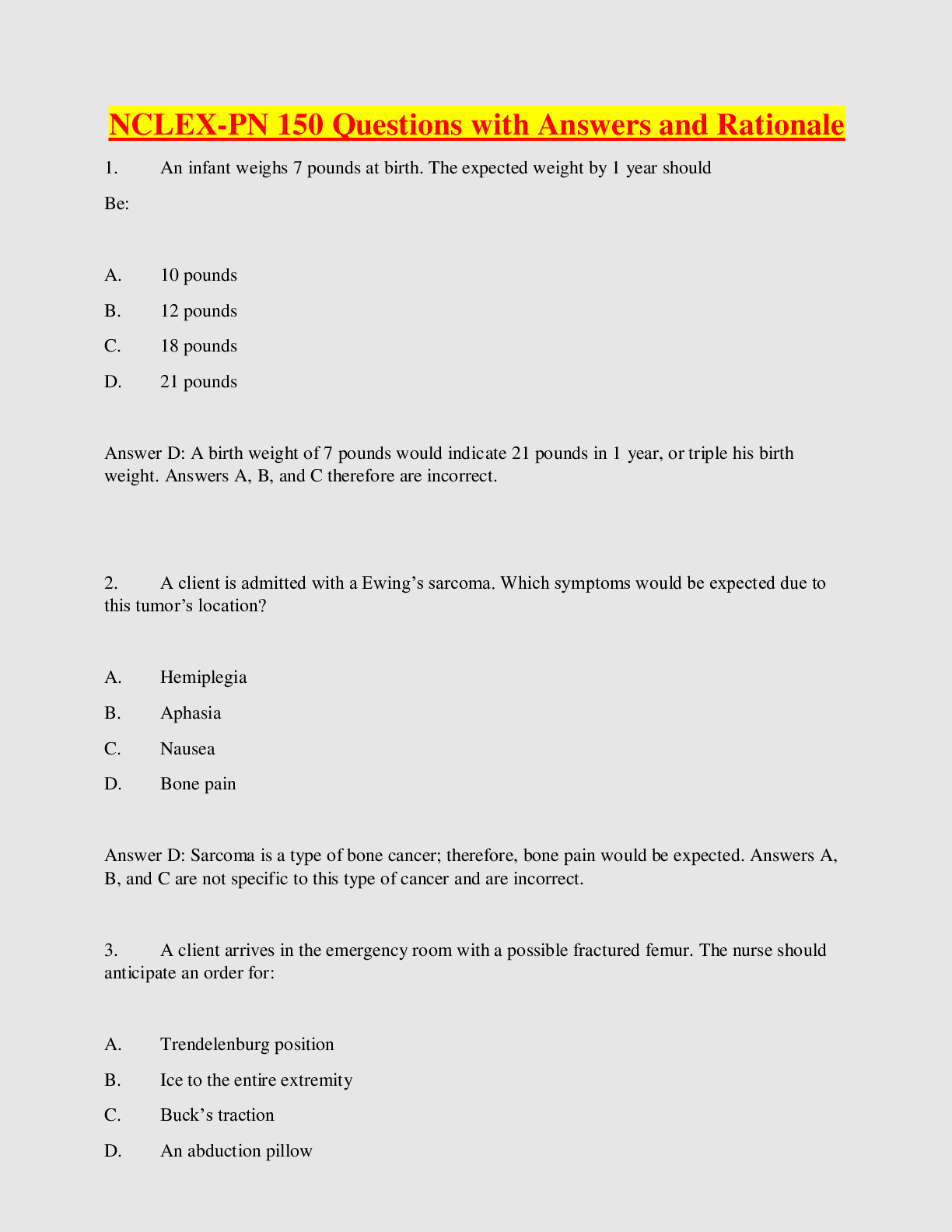


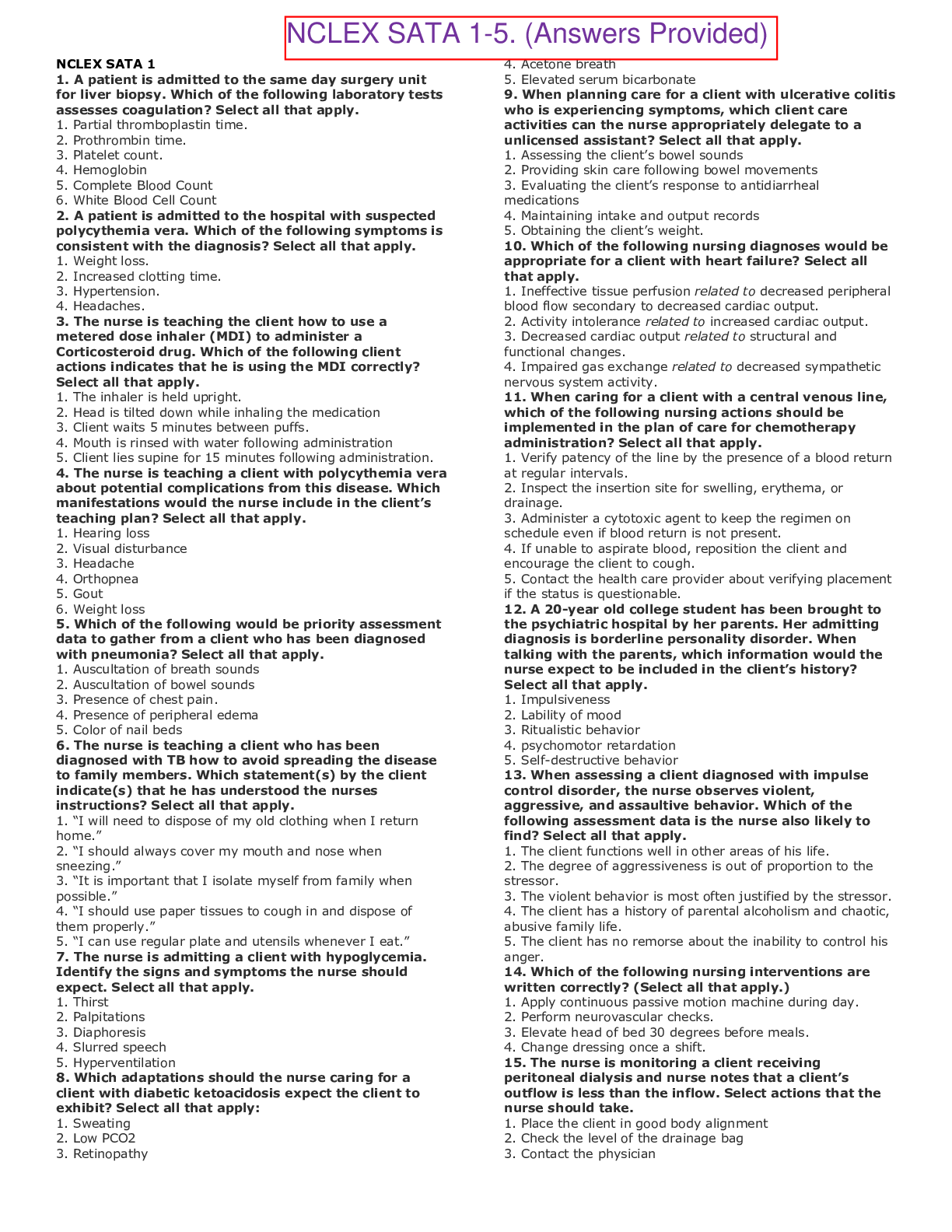
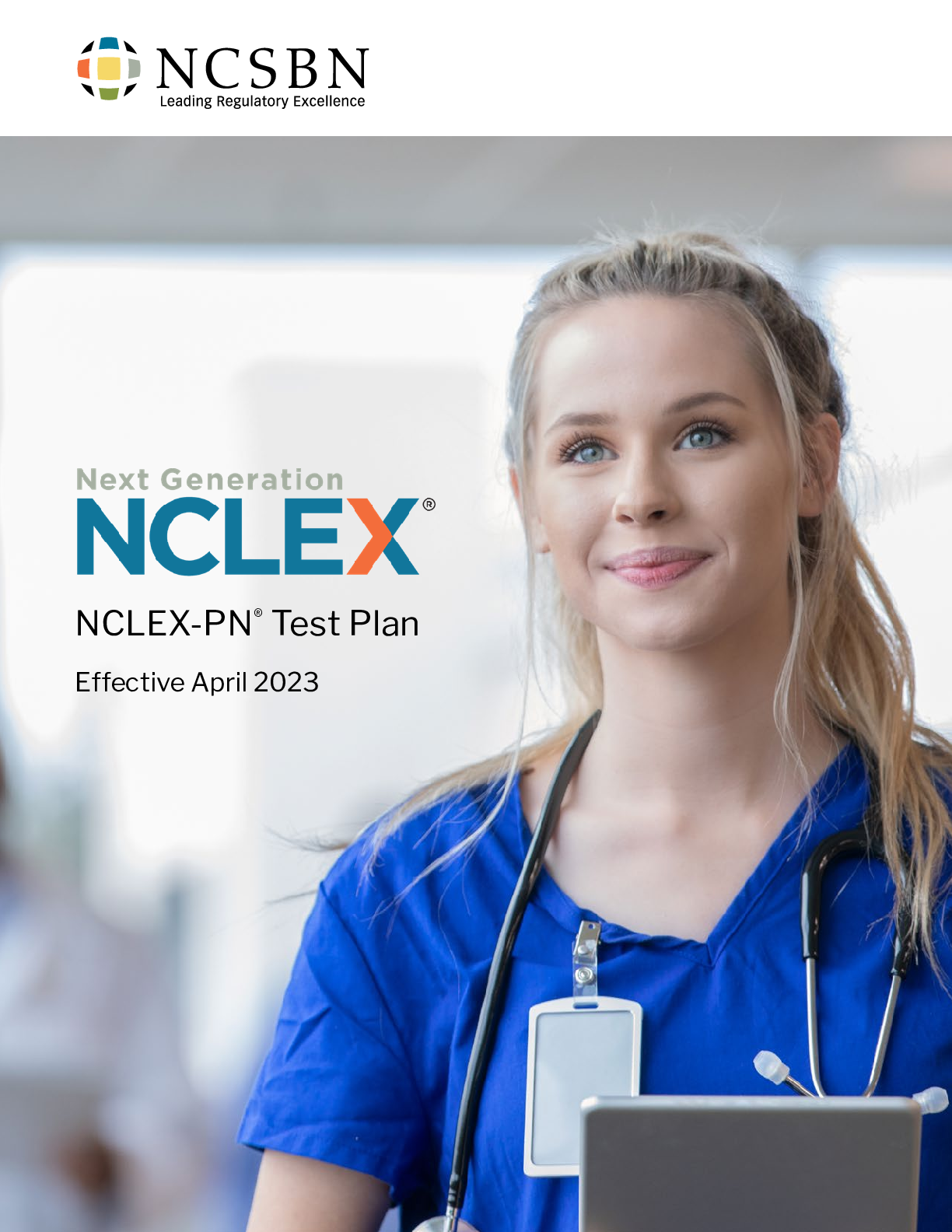

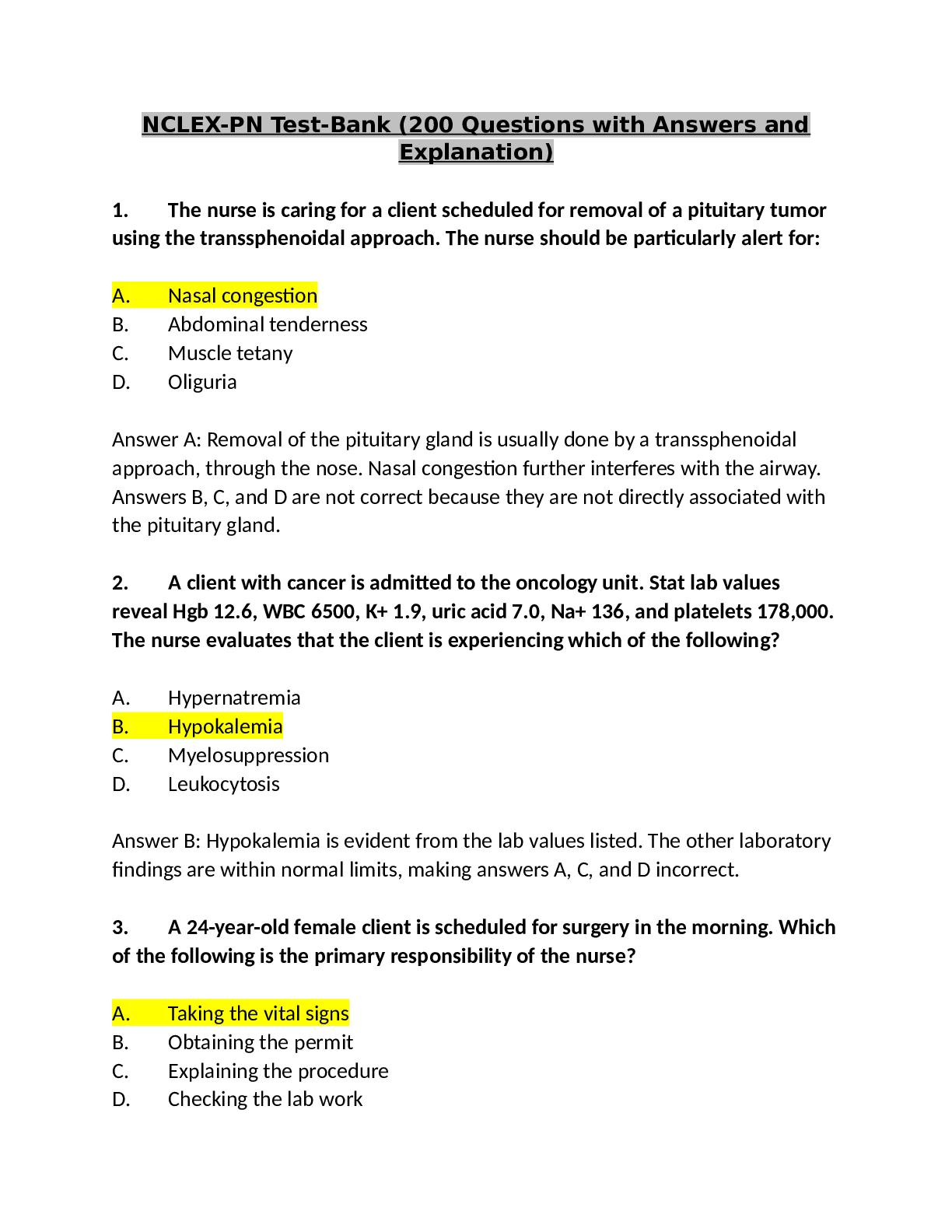

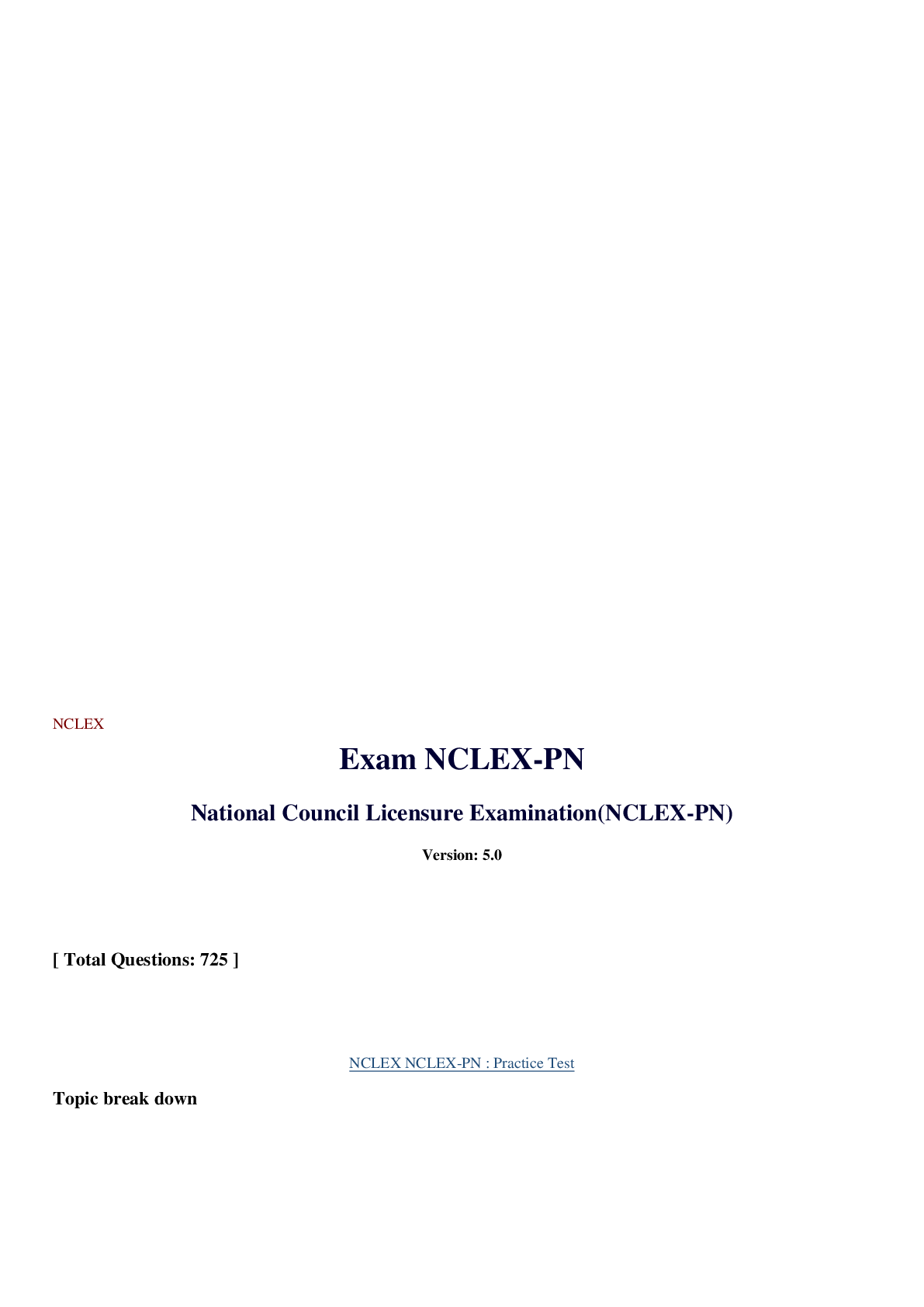
 Latest 2022-2023.png)

